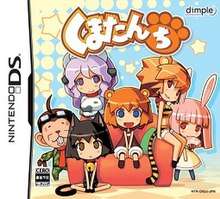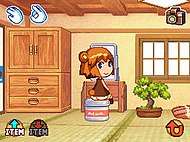Kumatanchi
Kumatanchi (くまたんち, Kuma-tan Zoo) is a life simulation video game co-developed for the Nintendo DS by Vanillaware and dōjin studio Ashinaga Oji-san. It was published on September 25, 2008 by Dimple Entertainment. The premise and gameplay revolves around the player taking care of an anthropomorphic girl based on the mascot character Habanero-tan, seeing her interactions with other anthropomorphic characters over two weeks in real-time. Due to its gameplay and subject matter, it was only released in Japan.
| Kumatanchi | |
|---|---|
 | |
| Developer(s) | Vanillaware Ashinaga Oji-san |
| Publisher(s) | Dimple Entertainment |
| Director(s) | Shigetake |
| Producer(s) | Nobuhiro Takagaki |
| Artist(s) | Shigetake |
| Composer(s) | Kimihiro Abe Mitsuhiro Kaneda |
| Platform(s) | Nintendo DS |
| Release |
|
| Genre(s) | Life simulation |
| Mode(s) | Single-player |
Vanillaware artist Shigetake acted as both director and character designer, with the game being an attempt by Vanillaware to produce two projects at the same time. Production was stressful due to staff shortages, putting Shigetake off the idea of directing any more games. The music, composed by Kimihiro Abe and Mitsuhiro Kaneda of Basiscape, was meant to break away from the company's traditional sound. Upon release, it met with low sales and mixed reviews from Japanese and Western journalists.
Gameplay

Kumatanchi is a life simulation video game, set in a zoo housing moe anthropomorphic young girls; the player assumes the role of a caretaker at a zoo, tasked with looking after new arrival "Kuma-tan".[1] The player is tasked with managing bear girl Kuma-tan, with interactions influencing Kuma-tan's mood and performance during public shows in the zoo.[2][3][4] The game takes place over two weeks in real-time, during which time the player is given charge of Kuma-tan and must raise her standing in the zoo by interacting with her as much as possible. The player interacts with her in her home, which can be outfitted with furniture and activities. Kuma-tan receives visits from other zoo inhabitants.[3][4]
Kuma-tan's mood and hunger levels are divided into five stages each, and can be maintained by feeding and interacting with her regularly. While players can give positive reinforcement to her with a nade-nade (なでなで, pat-pat), too much can make her become cocky, and may be balanced with a dekopin (とデコピン, forehead flick). Players may interact with other animals in the zoo, allowing Kuma-tan's mood to become better by taking part in conversations and activities, as well as purchase food from the zoo's shop.[2][3] Accessories are paid for with money earned by selling themed merchandise and pictures of Kuma-tan to zoo visitors, with some pictures of Kuma-tan's mood yielding higher cash depending on Kuma-tan's mood.[3] At the end of the two weeks, the player's choices are reflected in Kuma-tan's behavior.[4]
Development and release
Kumatanchi was co-developed by Vanillaware and the dōjin studio Ashinaga Oji-san.[5][6] Shigetake, who was a member of both developers, handled both direction and character design. The lead character is based on Habanero-tan, a mascot character of his design.[1][5][6] It was directed by Nobuhiro Takagaki from publisher Dimple Entertainment.[1][7] It was part of an attempt by Vanillaware to develop two games at the same time; Kumatanchi was in production alongside Muramasa: The Demon Blade. However, there were little to no staff for Kumatanchi, forcing Shigetake to act as both director and art designer. Due to this and the tight production schedule, development was tiring and discouraged Shigetake from taking on a directorial role again. It also prompted Vanillaware to abandon parallel game production at the time.[8]
Speaking about the character's broad appeal, Shigetake commented that while the game was intended to be a family-friendly experience for all ages, he admitted that the character and gameplay leant itself to a more adult perspective comparable with the style of Shimoneta. To research the game's zoo setting, three of the staff members went to Tennōji Zoo, with many of the game's props and activities based on their observations of the animal pens and zoo activities. The game's opening cinematic was inspired by anime openings, with Shigetake taking specific cues from the opening of Pani Poni Dash!. The team considered several titles for the game, including one based on an earlier dojin product of Ashinaga Oji-san before settling on Kumatanchi.[7]
The music was composed by Kimihiro Abe and Mitsuhiro Kaneda of Basiscape, a music company founded by Hitoshi Sakimoto which frequently collaborates with Vanillaware.[8][9] The aim for the music was to break away from Basiscape's traditional musical image, commemorating the company's launch of its self-titled commercial label. The score combined toy drums, melodica, recorder and ukulele to create a homely and comforting sound.[10] The game's opening and ending themes were performed by Ryouki Ruou.[9] The opening theme was intended to convey the energy of an anime opening.[7] A soundtrack album was released on December 16, 2009 by Basiscape and Sweep Records.[9][11] For the soundtrack version, a different sound source was used, creating a different sound from the in-game score.[9]
The game was announced in June 2008, after Vanillaware earlier hinted that they were working on a game for the Nintendo DS.[12][13] When announced, it was 70% complete.[13] It released on September 25, 2008.[14] A drama CD was published by Dimple Entertainment, first as a promotional item then as a limited commercial release.[15] The game was only released in Japan. In a 2009 interview, Vanillaware director George Kamitani stated that the game was denied localization due to its perception of training small girls.[16]
Reception
| Reception | ||||||
|---|---|---|---|---|---|---|
| ||||||
The game sold 3,500 copies in its debut week,[18] becoming the 4th highest-selling Nintendo DS game during that period.[19] Japanese gaming magazine Famitsu enjoyed the artwork and basic premise, but one reviewer felt that its real-time gameplay mechanic was intrusive, while another thought the game lacked substance.[17]
Joystiq commented on the game's visual style, which they felt was a departure from previous Vanillaware titles, stating that "That's not to say Kumatanchi looks bad (which, in turn, is not to say it looks good), but it's a lot more cutesy than what we were expecting."[12] Janine Dong of GamerTell was fairly mixed about the game; while she enjoyed the art design and some of its gameplay ideas, she found the general gameplay and interactions with Kuma-tan uncomfortable.[3]
References
- 『くまたんち』かわいい“くまたん”をお世話しよう. Famitsu (in Japanese). 2008-06-01. Archived from the original on 2019-06-07. Retrieved 2019-12-09.
- Vanillaware (2008-08-25). くまたんち マニュアル [Kumatanchi Manual] (in Japanese). Dimple Entertainment.
- Dong, Janine (2009-03-06). "Gamertell Review Kumatanchi for DS (Japanese import)". GamerTell. Archived from the original on 2009-03-10. Retrieved 2019-12-11.
- Nintendo - Title - くまたんち. Nintendo (in Japanese). Archived from the original on 2013-07-17. Retrieved 2019-12-11.
- Fletcher, JC (2008-06-05). "Kumatanchi Wallpaper Plus a Bit of Back Story". Joystiq. Archived from the original on 2015-01-27. Retrieved 2011-08-08.
- Ashcraft, Brian (2008-09-19). "The Lolita Animal Zoo Game Thing". Kotaku. Archived from the original on 2019-11-26. Retrieved 2011-08-08.
- Shigetake (2008). くまたんち 製作裏話. Shigetake website (in Japanese). Archived from the original on 2019-12-10. Retrieved 2019-12-11.
- "Jouji Kamitani Interview (Translation)". Gamengai. Archived from the original on 2014-11-11. Retrieved 2019-11-21.
- くまたんち おりじなる♪さうんどとらっく. Basiscape (in Japanese). Archived from the original on 2019-12-10. Retrieved 2019-12-11.
- おいでよって言われなくても行くよ!くまたんち!. Basiscape (in Japanese). 2011-10-14. Archived from the original on 2019-12-10. Retrieved 2019-12-11.
- くまたんち おりじなる・さうんどとらっく. Sweep Records (in Japanese). Archived from the original on 2019-12-10. Retrieved 2019-12-11.
- Savino, Candace (2008-06-02). "Kumatanchi looks like a vanilla Vanillaware game". Joystiq. Archived from the original on 2010-09-02. Retrieved 2011-08-08.
- くまたんち. Kumatanchi website (in Japanese). Archived from the original on 2013-04-16.
- ヴァニラウェア - Product. Vanillaware (in Japanese). Archived from the original on 2019-05-17. Retrieved 2019-12-09.
- コミックマーケット75 ディンプル出展案内. Dimple Entertainment (in Japanese). Archived from the original on 2009-03-21. Retrieved 2019-12-11.
- Fletcher, JC (2009-06-09). "Interview: Vanillaware's Jouji Kamitani on Muramasa". Joystiq. Archived from the original on 2011-02-24. Retrieved 2019-12-09.
- (DS) くまたんち. Famitsu (in Japanese). Archived from the original on 2013-06-26.
- "Enterbrain Top 30 Sales Chart Week 9/22 - 9/28". Weekly Famitsu (in Japanese). Enterbrain. 2008-10-10.
- Cowan, Danny (2008-09-26). "Saling the World: Lego Batman Tops US Multiplatform Charts". Gamasutra. Archived from the original on 2011-11-10. Retrieved 2011-08-08.